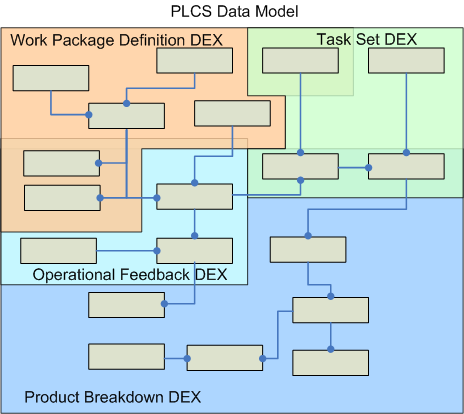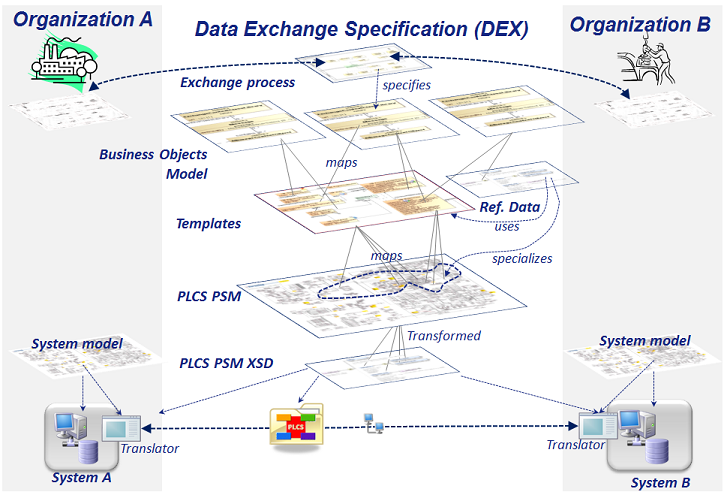The information model defined by ISO 10303-239 PLCS has a scope that is wider than most applications or any single data exchange. It is, therefore, unlikely that any software will be able to support or declare compliance to the entire range of information supported by ISO 10303-239 PLCS. Moreover, it would be impractical to contract for data compliant with ISO 10303-239 PLCS without a means of specifying the scope required. "Data EXchange specifications" ("DEXs") are defined in order to constrain the full information model to the scope required.
Definition: Data Exchange SpecificationData Exchange Specification - a subset of the ISO 10303-239 PLCS information model, designed to support data exchange for specific activities, providing guidance and rules for how to use and combine the selected entities and external Reference Data in that exchange. Each DEX includes a complete EXPRESS schema. This is a subset of the ISO 10303-239 schema with a derived XML Schema. Both can be used to define and validate a data exchange file. A DEX defined and managed by the OASIS PLCS TC may be referred to as a "PLCS DEX", as opposed to a "Business DEX".
Figure 1 shows how DEXs identify overlapping subsets of ISO 1030-239 PLCS data model.
The actual data (i.e. a package of data that is exchanged or shared, or a data exchange file) that is in accordance with a DEX information model is referred to as a DEX data set.
The DEXs are defined to support specific business processes. A DEX may support a part of, one, or several information flows (arrows) from the PLCS Activity Model defined in AP239. The PLCS DEXs can be used to:
- Automate the process of populating one single Life Cycle PDM system;
- Automate an ongoing exchange of data between different IT systems that are PLCS compliant and share the same information management rules; and
- Demonstrate compliance of a software application to an agreed set of information management rules, based on the PLCS standard.
The principle components of a DEX and their relationships are summarized in Figure 2. This shows the DEX in the center of the figure, with the DEX being used by two organizations A and B as the mechanism for the exchange.
The DEX provides a specification of how the PLCS PSM is used to support the exchange of data for a specific set of business requirements. The PLCS PSM is a SysML model with an associated XML Schema that defines data to be exchanged.
The DEX identifies a high level data exchange process that identifies the process triggers that will initiate a data exchange. For example, a maintenance request. The process is documented by identifying the exchanges in the Activity Model. The process may also be documented separately as a process model.
The information that is exchanged is first documented in the DEX as a Business Object model. This uses business terms to precisely specify the possible content of any exchange. The scope and content of the model is driven by the process model.
Having defined the Business Objects, the usage of the PLCS PSM to represent the Business Objects is then defined. That is the Business Objects are "mapped" to the PLCS PSM. This mapping is formally represented by Templates. Each Business Object will have a corresponding Template that specifies how the Business Object is represented using the PLCS PSM. In practice, the scope of DEXs will overlap, with similar business objects repeatedly using the same PLCS PSM constructs. Hence Templates are potentially reused by multiple DEXs.
As well as specifying how the PLCS PSM is used to represent a business object, a Template may identify the Reference Data that is applied to PLCS PSM. That is the Reference Data necessary to apply more precise semantics to the PLCS PSM in order that the business object is precisely mapped.
Having mapped the business object to the PLCS PSM, the complete subset of the PLCS PSM that is required by the DEX is identified and a corresponding XML Schema created. This XML Schema along with the Templates then provides the specification for translators that read and write the DEX data sets into the relevant systems. The XML Schema is also used to validate DEX data sets.
The DEX comprises the following sections:
- Introduction provides a introduction to the DEX and outlines it's purpose;
- Terms provides a definition of terms used in this DEX;
- Scope outlines the scope of the information covered by the DEX;
- ISO 10303-239 Activity Model Optional if the business activities that are supported by the DEX are within the scope of the ISO 10303-239 Activity model then those activities are identified;
- Business Overview provides a high level overview of the business process / application that this DEX is intended to support;
- Business Information Overview provides a high level overview of the business information that can be represented by this DEX;
- Business Information Model provides a more detailed overview of the information that the business process / application described in Business Overview requires;
- PLCS PSM Representation provides technical details of how the business information requirements identified in Business Information Model are represented using PLCS PSM;
- Example data sets lists a set of example XML datasets that have been instantiated in accordance with this DEX.
- Templates lists all the templates that are used in the definition of this DEX;
- Schemata identifies the schemata that define this DEX. The overarching schema is the PLCS PSM. The DEX specifies subsets of this schema that are to be used for a specific exchange purpose.
- Reference Data lists the reference data classes used by this DEX;
- Conformance defines the requirements for applications to conform to this DEX.






